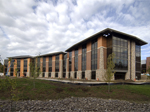The LEED Green Building Rating SystemTM is a voluntary, consensus-based national standard for developing high-performance, sustainable buildings. LEED was created by the U.S. Green Building Council to define “green building” through a common standard, and to promote integrated, whole-building design practices. There are several categories of LEED building certification programs including: LEED for New Construction, LEED for Existing Buildings, LEED for Schools, and LEED for Retail, just to name a few. And as of last week, the U.S.G.B.C. announced plans to adopt a new LEED category in 2009: Healthcare.
Reportedly, LEED for Healthcare will use the language of the AIA Interim Guideline as the basis for two new “Environmental Quality” acoustic credits:
- EQ Credit 2.1 -Room Noise Levels, Sound Isolation, Paging & Call Systems (AIA Guide 3-5)
- EQ Credit 2.2 – Exterior Noise, Acoustical Finishes, & & Building Vibration (AIA Guide 1, 2, & 6)
By adopting these new “acoustical points,” LEED attests to the importance of acoustical design in healthcare facilities. Proper acoustical design reduces patient disturbance, improves the healing environment, and increases patient satisfaction. Further, it positions the healthcare facility as a good neighbor in the community by reducing exterior noise. It is the job of acoustical consultants to work with healthcare facilities and local architects to engineer acoustical features that meet these goals in a way that is helpful, cost effective, and most importantly, green. As LEED for Healthcare comes online in 2009, be prepared for acoustics (as an element of “Environmental Quality”) to be addressed in other LEED categories as well.
